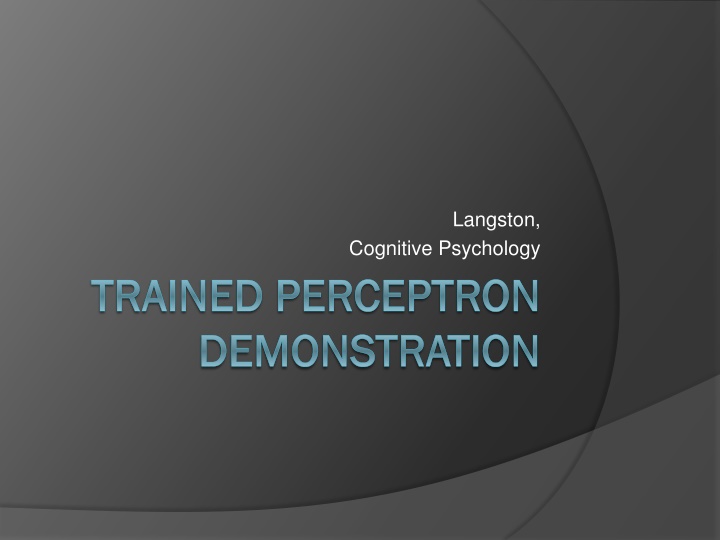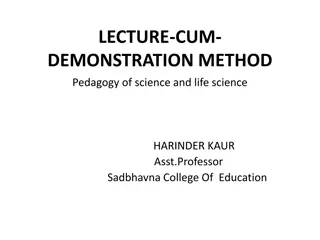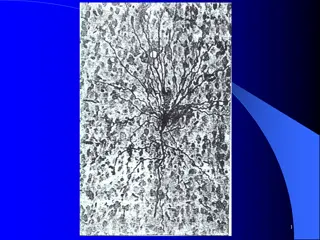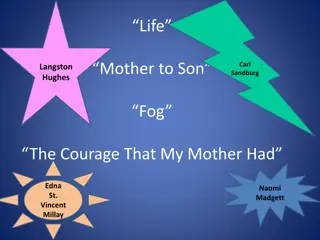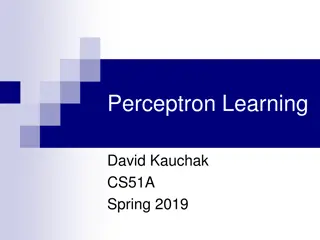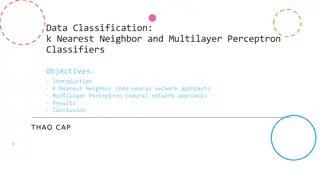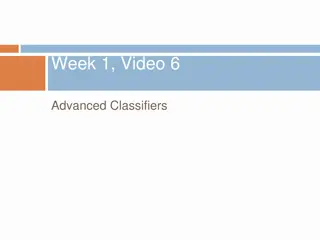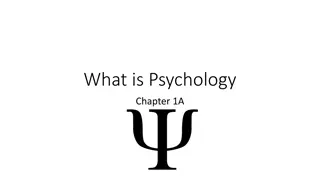Langston Cognitive Psychology: Trained Perceptron Demonstration
In the field of cognitive psychology, a trained perceptron is demonstrated through categorizing fruits based on features like taste, seeds, and skin. The process involves training the perceptron to distinguish good fruits from bad ones using specific criteria. The weights on the links play a crucial role in the perceptron's decision-making process, where the knowledge lies. By understanding the workings of the perceptron, one can grasp its ability to classify objects based on provided features and thresholds.
Download Presentation

Please find below an Image/Link to download the presentation.
The content on the website is provided AS IS for your information and personal use only. It may not be sold, licensed, or shared on other websites without obtaining consent from the author.If you encounter any issues during the download, it is possible that the publisher has removed the file from their server.
You are allowed to download the files provided on this website for personal or commercial use, subject to the condition that they are used lawfully. All files are the property of their respective owners.
The content on the website is provided AS IS for your information and personal use only. It may not be sold, licensed, or shared on other websites without obtaining consent from the author.
E N D
Presentation Transcript
Langston, Cognitive Psychology TRAINED PERCEPTRON TRAINED PERCEPTRON DEMONSTRATION DEMONSTRATION
Trained Perceptron I trained the following perceptron on the category good fruit defined as anything with edible skin and seeds. We ll show it various fruits and have it categorize them as good or bad fruits to see how it performs.
Trained Perceptron Remember our features: Taste Seeds Skin Sweet = 1, Not_Sweet = 0 Edible = 1, Not_Edible = 0 Edible = 1, Not_Edible = 0 For output: Good_Fruit = 1 Not_Good_Fruit = 0
Trained Perceptron Problem space: Banana 1 1 0 0 Pear 1 0 1 0 Lemon 0 0 0 0 Strawberry 1 1 1 1 Green apple 0 0 1 0 Taste Seeds Skin Good fruit?
Trained Perceptron Problem space: Note that the category (whether or not it s a good fruit) is now in the table Banana 1 1 0 0 Pear 1 0 1 0 Lemon 0 0 0 0 Strawberry 1 1 1 1 Green apple 0 0 1 0 Taste Seeds Skin Good fruit?
Trained Perceptron Here is the trained perceptron: Input Taste 0.0 Output 0.25 Seeds 0.25 If > 0.4 then fire Skin
Models of Semantic Memory Contrast it to the leading symbolic model. Collins & Loftus (1975, p. 412)
Trained Perceptron The knowledge is in the weights on the links (rather than in the nodes): Input Taste 0.0 Output 0.25 Seeds 0.25 If > 0.4 then fire Skin
Trained Perceptron The way it works is: You show it an example. If the feature has a value of 1, that is multiplied by the weight and put in the sum. If the value is zero, it won t add to the sum because 0 times anything = 0. Add up all of the products of multiplying features times weights.
Trained Perceptron The way it works is: Once you have a sum, you compare that to some threshold for responding. If the sum is larger than the threshold, respond yes. If the sum is smaller than the threshold, respond no. Let s look at the perceptron and classify our fruits.
Trained Perceptron Show it a banana: Input 1 1 Taste 0.0 Output 0.25 Seeds 1 1 .00 0.25 If > 0.4 then fire Skin 0 0
Trained Perceptron Show it a banana: Input 1 1 Taste 0.0 Output 0.25 Seeds 1 1 .25 0.25 If > 0.4 then fire Skin 0 0
Trained Perceptron Show it a banana: Input 1 1 Taste 0.0 Output 0.25 Seeds 1 1 .25 0.25 If > 0.4 then fire Skin 0 0
Trained Perceptron Show it a banana: Input 1 1 Taste 0.0 Output 0.25 Seeds 1 1 .25 0 0.25 If > 0.4 then fire Skin 0 0
Trained Perceptron In this case we have: (1 X 0) = 0 + (1 X 0.25) = 0.25 + (0 X 0.25) = 0 It adds up to 0.25. Since that is less than the threshold (0.40), we responded no. Is that correct (banana is not a good fruit)? (Yes, it s correct.)
Trained Perceptron Show it a pear: Input 1 1 Taste 0.0 Output 0.25 Seeds 0 0 .00 0.25 If > 0.4 then fire Skin 1 1
Trained Perceptron Show it a pear: Input 1 1 Taste 0.0 Output 0.25 Seeds 0 0 .00 0.25 If > 0.4 then fire Skin 1 1
Trained Perceptron Show it a pear: Input 1 1 Taste 0.0 Output 0.25 Seeds 0 0 .25 0.25 If > 0.4 then fire Skin 1 1
Trained Perceptron Show it a pear: Input 1 1 Taste 0.0 Output 0.25 Seeds 0 0 .25 0 0.25 If > 0.4 then fire Skin 1 1
Trained Perceptron In this case we have: (1 X 0) = 0 + (0 X 0.25) = 0 + (1 X 0.25) = 0.25 It adds up to 0.25. Since that is less than the threshold (0.40), we responded no. Is that correct (pear is not a good fruit)? (Yes, it s correct.)
Trained Perceptron Show it a lemon: Input 0 0 Taste 0.0 Output 0.25 Seeds 0 0 .00 0.25 If > 0.4 then fire Skin 0 0
Trained Perceptron Show it a lemon: Input 0 0 Taste 0.0 Output 0.25 Seeds 0 0 .00 0.25 If > 0.4 then fire Skin 0 0
Trained Perceptron Show it a lemon: Input 0 0 Taste 0.0 Output 0.25 Seeds 0 0 .00 0.25 If > 0.4 then fire Skin 0 0
Trained Perceptron Show it a lemon: Input 0 0 Taste 0.0 Output 0.25 Seeds 0 0 .00 0 0.25 If > 0.4 then fire Skin 0 0
Trained Perceptron In this case we have: (0 X 0) = 0 + (0 X 0.25) = 0 + (0 X 0.25) = 0 It adds up to 0.00. Since that is less than the threshold (0.40), we responded no. Is that correct (lemon is not a good fruit)? (Yes, it s correct.)
Trained Perceptron Show it a strawberry: Input 1 1 Taste 0.0 Output 0.25 Seeds 1 1 .00 0.25 If > 0.4 then fire Skin 1 1
Trained Perceptron Show it a strawberry: Input 1 1 Taste 0.0 Output 0.25 Seeds 1 1 .25 0.25 If > 0.4 then fire Skin 1 1
Trained Perceptron Show it a strawberry: Input 1 1 Taste 0.0 Output 0.25 Seeds 1 1 .50 0.25 If > 0.4 then fire Skin 1 1
Trained Perceptron Show it a strawberry: Input 1 1 Taste 0.0 Output 0.25 Seeds 1 1 .50 1 0.25 If > 0.4 then fire Skin 1 1
Trained Perceptron In this case we have: (1 X 0) = 0 + (1 X 0.25) = 0.25 + (1 X 0.25) = 0.25 It adds up to 0.50. Since that is greater than the threshold (0.40), we responded yes. Is that correct (strawberry is a good fruit)? (Yes, it s correct.)
Trained Perceptron Show it a green apple: Input 0 0 Taste 0.0 Output 0.25 Seeds 0 0 .00 0.25 If > 0.4 then fire Skin 1 1
Trained Perceptron Show it a green apple: Input 0 0 Taste 0.0 Output 0.25 Seeds 0 0 .00 0.25 If > 0.4 then fire Skin 1 1
Trained Perceptron Show it a green apple: Input 0 0 Taste 0.0 Output 0.25 Seeds 0 0 .25 0.25 If > 0.4 then fire Skin 1 1
Trained Perceptron Show it a green apple: Input 0 0 Taste 0.0 Output 0.25 Seeds 0 0 .25 0 0.25 If > 0.4 then fire Skin 1 1
Trained Perceptron In this case we have: (0 X 0) = 0 + (0 X 0.25) = 0 + (1 X 0.25) = 0.25 It adds up to 0.25. Since that is less than the threshold (0.40), we responded no. Is that correct (green apple is not a good fruit)? (Yes, it s correct.)
Trained Perceptron Using the perceptron we can correctly categorize each of the fruit examples we looked at. The next question is How did we get the weights that represent its knowledge of the category? Look at the perceptron learning demonstration for that
END TRAINED END TRAINED PERCEPTRON PERCEPTRON DEMONSTRATION DEMONSTRATION
